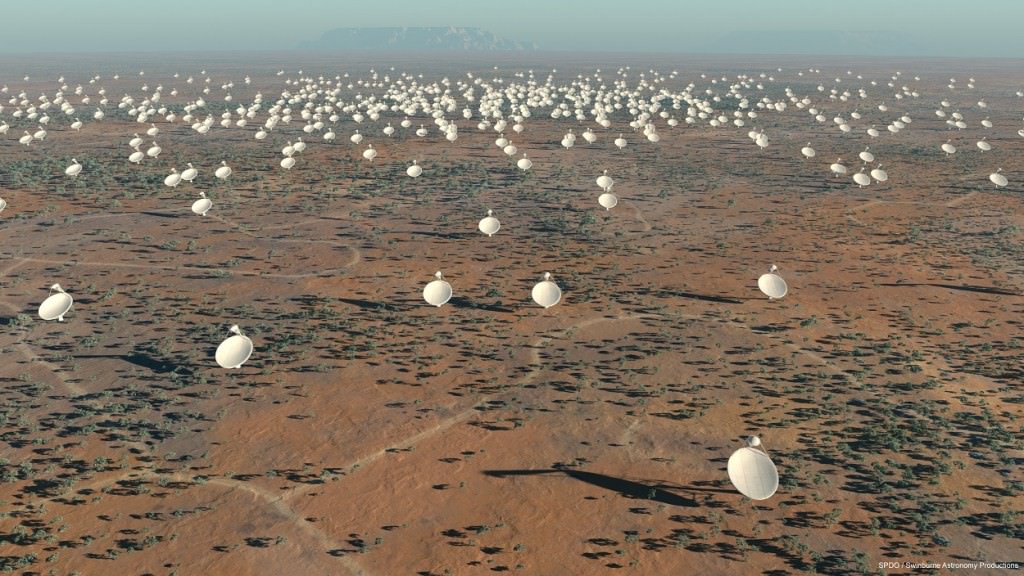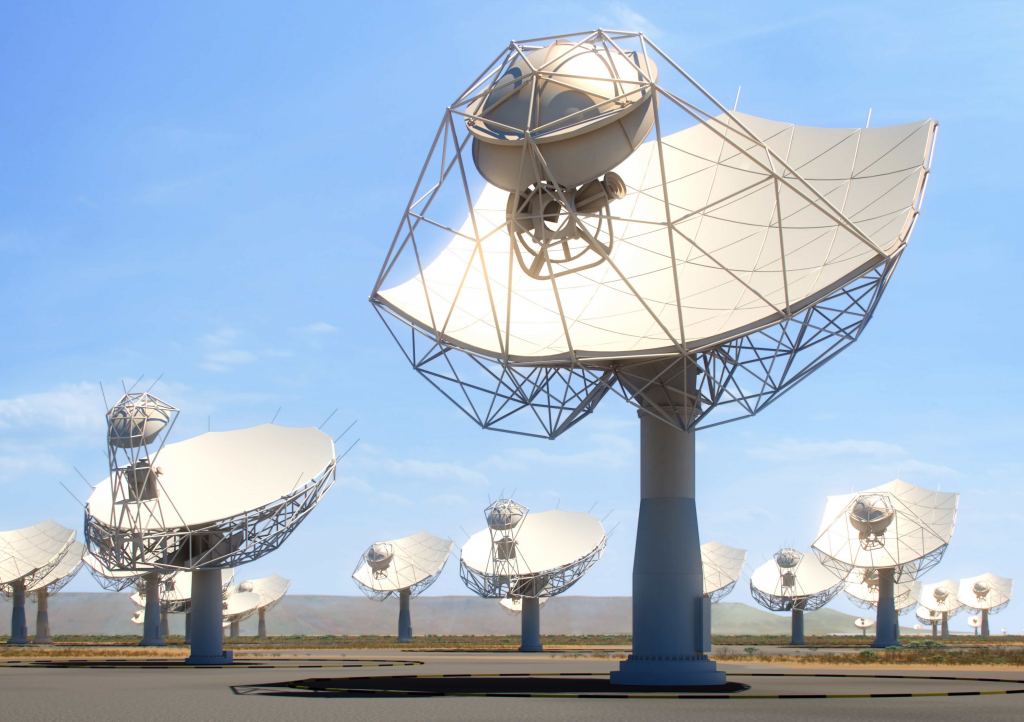In the coming years, a number of next-generation observatories and arrays will become operational. These facilities will make major contributions to multiple fields of astronomy: exploring the mysteries of the early Universe, studying gravitational waves, determining the role of dark matter and dark energy in cosmic evolution, and directly image “Earth-like” exoplanets.
Unfortunately, this revolutionary development in astronomy may be going up against another major project: the creation of mega-constellations. Because of this, the SKA Organization (SKAO) – which oversees the international Square Kilometre Array (SKA) – is insisting that corrective measures be taken so satellites won’t interfere with its radio observations once it’s operational.
Conceived in the 1990s, the Square Kilometre Array is an international collaboration that seeks to build and operate the world’s largest radio observatory. The project involved thousands of scientists and engineers from 15 countries and three pathfinder facilities in Western Australia and South Africa – including the Australian Square Kilometre Array Pathfinder, the Murchison Widefield Array (MWA) and the MeerKAT array.

Owing to the fact that they use many of the same frequency ranges as radio telescopes, there has always been concerns about the potential for Radio Frequency Interference (RFI) from satellites. In the past, radio observatories has been able to conduct observations in the same frequency ranges due to the small number of (visible) satellites and their fixed position in geostationary orbit (GSO) around Earth.
As of Aug. 1st, 2020, there are 2,787 satellites operating in orbit around Earth. But in the coming years, that number is projected to grow to 6,400, with some estimates claiming that it might reach as high as 100,000. This is expected to cause considerable interference to radio telescopes, particularly ones like the SKA-Mid telescope that will soon be constructed in South Africa.
This telescope array will consist of 197 radio dishes scanning the sky in the mid-frequency range. Of particular concern are satellite signals in the Band 5b range, which coincide with some of the SKA-Mid telescope’s receivers. The SKAO’s low-frequency telescope in Western Australia, which uses different antenna technology, was not included in this analysis.
The SKAO recommendations came after they made a thorough analysis that quantified the impact that proposed constellations of satellites – like SpaceX’s proposed Starlink constellation – will have in the coming years. Overall, the SKAO analysis focused on three major categories. First, they considered the potential for physical damage.

For this category, the concern is that intense radio signals from the satellites might have the potential to directly illuminate the SKA’s dishes. However, their study was about to rule out these concerns. Second, there’s the potential for instrument saturation, as very strong radio interference can saturate a receiver system to the point where all other signals are drowned out.
This will lead to the loss of all data in the frequency band, thus rendering the receiver temporarily useless. Saturation is expected to occur for a short time during the first phase of constellation deployment (for 6,400 satellites). For 100,000 satellites, saturation without mitigation measures would be continuous. Last, there is the scientific impact caused by large constellations.
Even with the smaller projected size of 6,400 satellites, the SKAO anticipates that all astronomical observations within the frequency range of satellite transmissions are likely to experience a continuous loss of sensitivity. The impact will be most significant for studies of complex organic and extragalactic molecules (among others). As Dr Robert Braun, SKA Science Director, explained in a SKAO statement:
“There is tremendous scientific and public interest in identifying the origins of life beyond that found on Earth and one of the most promising methods of tracking it down elsewhere in our Galaxy is the detection of complex prebiotic molecules, whose spectral signatures are concentrated between about 10 and 15 GHz. This is only one of many exciting science goals that depend on sensitive access to this frequency range. The prospect of losing sensitivity in this key frequency band is extremely worrying.“

From this, the analysts came to a number of conclusions. Among them the fact that satellites broadcasting in the Band 5b range will generate interference that could result in a loss of sensitivity in that range. The further estimated that will increase the amount of time astronomers need to study particular objects in the sky in order to observe them clearly (aka. integration time) by 70%.
In short, radio observatories will only be able to carry out slightly more than half as many observations in that band. The analysis also found that for significantly larger constellations (up to 100,000 satellites), the effect on the SKA would be much worse. In this case, they estimates that astronomy in the Band 5b range could experience up to 100% interference. Said Dr Braun:
“A loss of observing efficiency on top of the expected large oversubscription on the telescope will translate directly into lost science and it is quite possible that the most challenging experiments that might otherwise have been undertaken will no longer be viable at all in these circumstances.”
The strategies they identified include ensuring that the satellite transmitters don’t point their beams near the SKAO dishes. This would require a simple software modification that will instruct satellites to steer their beams away from the telescope site, a measure the SKAO insists will not affect the deployment, positioning or hardware of the constellations.

The analysts were sure to note that operators already use this technique, in compliance with international regulations, to avoid affecting telecommunications and TV transmissions when crossing paths with GSO satellites. If followed, this strategy could reduce possible interference with the SKA-Mid telescope by a factor of 10 and reduce the increase in integration time to just 7%.
While any level of interference is regrettable, the SKA indicated that some degree of compromise is necessary. In the meantime, provided all those involved comply with the analysis’ recommendations, it will be possible to keep that interference to a minimum. Said Prof. Philip Diamond, SKA Director-General:
“Thanks to our modelling work, the potential impact of satellite mega-constellations on the SKA is now understood. We are building a multi-billion euro state-of-the-art research facility funded by taxpayers around the world, and we need to protect and maximize its ability to deliver innovation and new knowledge for humanity.”
In addition, they pointed out that the Astronomy Geographic Advantage (AGA) Act has already severely limited commercial incentives for companies looking to aim their beams towards the SKA-Mid site. This measure, passed by South Africa’s parliament in 2007, regulates how and where satellite operators can install ground-based infrastructure in the area around the SKA-Mid site to establish a “radio-quiet” zone.

Speaking of mitigation, these recommendations were made just six months after Elon Musk announced that all future Starlink deployments would consist of “DarkSat” satellites. Appropriately named, this design relies on a darkened phased array and parabolic antennas to reduce brightness by an estimated 55%. Musk’s stated commitment to ensuring that his constellation would not impact astronomy is something the SKAO plans to hold him to!
Beyond the SKA, the astronomical community has expressed concern over how planned satellite constellations could disrupt next-generation optical and radio facilities like the Vera C. Rubin Observatory – (formerly the Large Synoptic Survey Telescope (LSST) – and the Event Horizon Telescope (EHT) – which acquired the first-ever image of a black hole!
Beyond the problem of radio interference, the prospect of thousands of more satellites in orbit raises the issue of “space junk.” At present, there are many Earth-based and space-based strategies in the works to address these problems. However, these will likely need to be accelerated to ensure that our skies and radio bands remain clear and unfettered!
Further Reading: SKA

